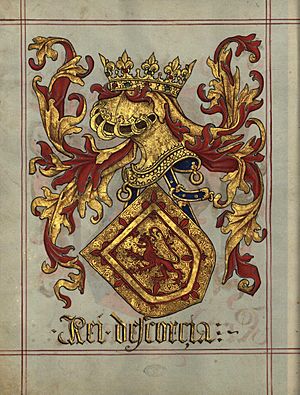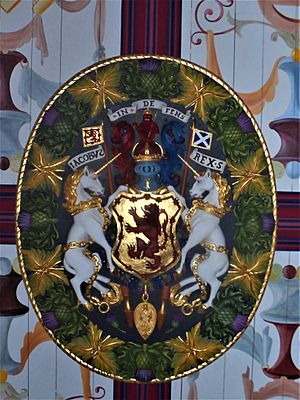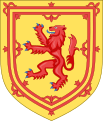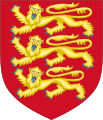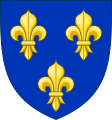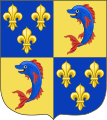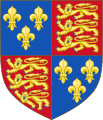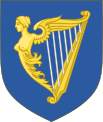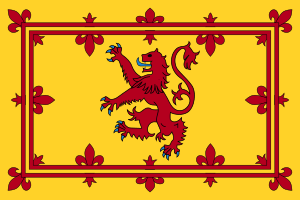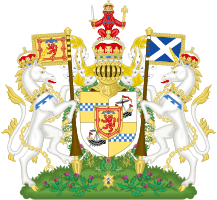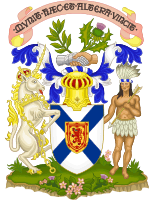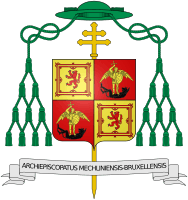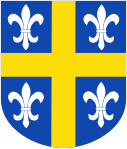Royal arms of Scotland facts for kids
Quick facts for kids Royal Arms of Scotland |
|
|---|---|
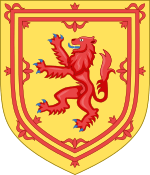 |
|
| Armiger | Monarchs of Scotland |
| Adopted | Late Middle Ages |
| Blazon | Or a lion rampant Gules armed and langued Azure within a double tressure flory-counter-flory of the second |
| Motto | Scots: In My Defens God Me Defend (abbr. In Defens) |
| Use | Quartered in current royal arms |
The royal arms of Scotland are the official coat of arms used by the King of Scots. These arms were first used in the 12th century. When James VI became King of England and Ireland in 1603, the Scottish arms were combined with the arms of England and Ireland. Even though Scotland and England shared the same king, they kept their own special royal arms.
When Scotland and England joined to form Great Britain in 1707, they still used different royal arms in Scotland than in other places. The Scottish arms are often called "the ruddy lion ramping in his field of tressured gold." They are still a very important symbol of Scotland today. You can see them as part of the royal arms of Queen Elizabeth II.
The flag version of these arms is called the Royal Banner or, more commonly, the Lion Rampant. Many officials in Scotland still use this banner.
Contents
What Do the Royal Arms Look Like?
The royal arms of Scotland have several cool parts:
The Shield: Lion and Border
The main part is a red lion standing on its back legs (called "rampant"). This lion has a blue tongue and blue claws. It is inside a red double border. This border is decorated with fleurs-de-lis (flower-like symbols). This special border is known as the royal tressure.
People used to think the fleurs-de-lis showed a link with France. But this is probably not true. The royal tressure was part of the arms before Scotland and France became allies. It was likely added to make the arms unique. Many other kings and lords already used a rampant lion symbol.
The Top: Helm and Crest
Above the shield, you'll see a golden helm. On top of the helm is the crest. The crest shows the red lion facing forward. It is sitting on the Crown of Scotland. This lion holds the Sceptre and the Sword of State, which are important Scottish royal items.
The Mottoes
Above the crest, there is a saying: "In Defens". This is a shorter way of saying "In My Defens God Me Defend". "Defens" is the Scots language spelling of "defence."
Around the shield, there is a special chain. This chain is the collar of the Most Ancient and Most Noble Order of the Thistle. This is a very important Scottish award.
The Supporters: Unicorns
Two crowned and chained unicorns stand on either side of the shield. These are called "supporters." The unicorn on the right (from the shield's point of view) holds a flag with the royal arms. The unicorn on the left holds the national flag of Scotland. Unicorns were seen as strong and dangerous animals. They are always shown chained in the arms. This shows that even powerful creatures can be controlled.
The Base: Thistles
At the very bottom, there are thistles. The thistle is the national flower of Scotland. Later versions of the arms also added a blue ribbon here. On the ribbon, you can read the motto of the Order of the Thistle: Nemo me impune lacessit. This means "No one provokes me with impunity."
History of the Royal Arms
Early Days in Scotland
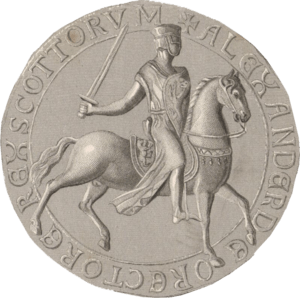
The first time we see these arms was with King William the Lion in the 12th century. But it's hard to see them clearly on his seal. However, a lion can be clearly seen on the seal of his son, Alexander II. Over time, the arms changed slightly. Sometimes the lion held a sword or wore a crown. These small changes often happened because different artists or stonemasons made them.
In the time of King James III, the Scottish Parliament tried to remove the double border (royal tressure). But this change did not last long. King James III soon put the royal tressure back on the arms.
Changes with France
When Mary, Queen of Scots married Francis, the French Dauphin (who was next in line to be King of France) in 1558, her Scottish arms were combined with his. For a short time, Mary also claimed the English crown. So, the arms of England were added too. But this claim was given up in 1560. When Francis became King of France, their arms changed again to show their new royal status. After Francis died, Mary continued to use arms that showed Scotland and France together.
The Union of the Crowns
| Royal coat of arms of Scotland | |
|---|---|
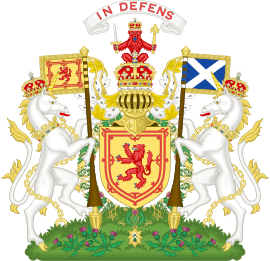 |
|
| Versions | |
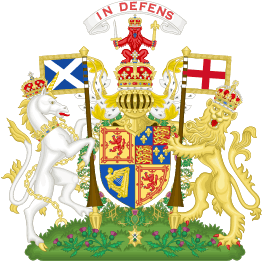
Coat of arms of James VI from 1603 as both the King of Scots and as King James I of England, France, and Ireland.
|
|
| Armiger | James VI, King of Scots, ultimate armiger of pre-1603 version |
| Adopted | Late Middle Ages |
| Crest | Upon the Royal helm the crown of Scotland Proper, thereon a lion sejant affronté Gules armed and langued Azure, Royally crowned Proper holding in his dexter paw a sword and in his sinister a sceptre, both Proper |
| Blazon | Or a lion rampant Gules armed and langued Azure within a double tressure flory-counter-flory of the second |
| Supporters | Unicorns Argent Royally crowned Proper, armed, crined and unguled Or, gorged with a coronet of the second composed of crosses patée and fleurs de lis a chain affixed thereto passing between the forelegs and reflexed over the back also of the second. Sinister holding the standard of Saint Andrew, dexter holding the banner of the Royal arms |
| Compartment | a compartment underneath from which issue thistles one towards each side of the escutcheon |
| Motto | Scots: In My Defens God Me Defend (abbr. In Defens) |
| Order(s) | The Most Ancient and Most Noble Order of the Thistle. (Arms feature the collar of the order) |
When James VI became King of England and Ireland in 1603, the arms of England and Ireland were added to the Scottish arms. At this time, the King of England also claimed the French throne. So, the arms of France were also included. James used a different version of his royal arms in Scotland. This difference continued even after the Acts of Union in 1707. Today, the Royal Arms of the United Kingdom used in Scotland are still different from those used elsewhere.
During the time of King Charles II, the Latin motto of the Order of the Thistle was added to the royal arms used in Scotland. This motto is Nemo me impune lacessit. It appears on a blue scroll below the shield. This made sure that the Scottish royal arms had two mottoes, just like the royal arms used in England.
After 1603, the royal arms also included the harp of Ireland. This harp represents Ireland. Today, the royal arms of the United Kingdom still show an Irish harp. This represents Northern Ireland.
Changes to the Arms Over Time
The royal arms of Scotland have changed many times:
- After Mary, Queen of Scots married in 1558, the arms included parts from:
-
- The Dauphin of France (1558–1559)
- The Kingdom of England (1558-1560)
- The Kingdom of France (1559–1565)
- After the Union of the Crowns in 1603, the arms included parts from:
-
- The Kingdom of France (1603–1707)
- The Kingdom of England (1603–1707)
- The Kingdom of Ireland (1603–1707)
- After Charles II's reign, the motto of the Order of the Thistle, Nemo me impune lacessit, was added.
- After the Acts of Union in 1707, the arms used in Scotland included parts from:
-
- The Kingdom of France (1707–1800)
- The Kingdom of Ireland (1707–1800)
- The Electorate of Hanover (1714–1800)
- After the Act of Union in 1800, the arms used in Scotland included parts from:
-
- The Electorate of Hanover (1801–1814)
- The Kingdom of Hanover (1814–1837)
- When Queen Victoria became queen in 1837, the modern royal arms of the United Kingdom were created.
-
Arms of Scotland
-
Arms of England
-
Arms of France
-
Arms of the Dauphin of France
-
Arms of Ireland
-
Arms of the House of Orange-Nassau
-
Arms of the House of Hanover
The Royal Arms as a Flag
Since Great Britain was formed, the Scottish arms are usually seen with the arms of England and Ireland. However, the original royal banner of Scotland, also known as the "Lion Rampant," is still used officially in Scotland. It flies from royal buildings when the Queen is not there. It is also used by important officials like the First Minister. People also often use it unofficially as a second national flag, especially at Scottish sports events.
How the Royal Arms Are Used Today
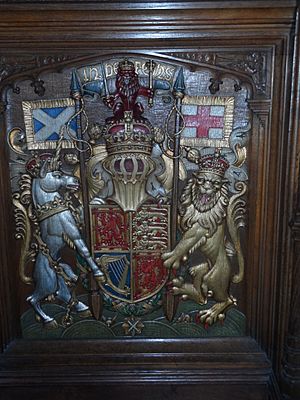
The royal arms we see today were adopted when Queen Victoria became queen in 1837. In these arms, the Scottish arms are in the first and fourth sections of the shield. The English arms are in the second section, and the Irish arms are in the third. The Scottish motto In Defens is still there. The Latin motto of the Order of the Thistle, Nemo me impune lacessit, is also on a blue scroll.
The Scottish unicorn and English lion hold flags. The unicorn is on the right side, which is the more important position. The shield is surrounded by the collar of the Order of the Thistle.
The arms of the Duke of Rothesay (who is the heir to the Scottish throne) also include the royal arms of Scotland.
The coat of arms of Gibraltar and the royal arms of Canada also feature the Scottish arms. They both use the unicorn as a supporter.
Both the flag and arms of Nova Scotia (a province in Canada) have parts of the Scottish arms. Their arms show the unicorn as the main supporter, in the Scottish style.
The royal tressure (the double border with fleurs-de-lis) is also seen on the arms of many Scottish families and groups. This shows that they have received special favor from the royal family. Examples include the cities of Perth and Aberdeen.
The arms of the Archdiocese of Mechelen in Belgium used to be the same as Scotland's. They are now combined with the arms of Brussels. Some people think this is because Saint Rumbold, a patron saint, was an Irish monk. In old times, Irish monks were called "Scotii." Another idea is that Saint Rumbold was the son of a Scottish King.
The town of Sankt Wendel in Germany also has elements of the Scottish flag and arms. Four lilies from the Scottish royal arms are on a blue background. This reminds people of Saint Wendelin. Legend says he was a Scottish king's son. In 1465, the town sent people to Scotland to check this story. After they supposedly confirmed it, the Scottish lion arms were used in the town's seal.
|
|
|
|
|
|
See also
 In Spanish: Escudo de Escocia para niños
In Spanish: Escudo de Escocia para niños




